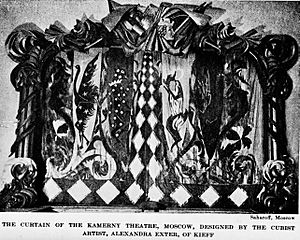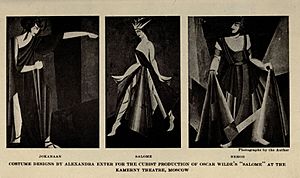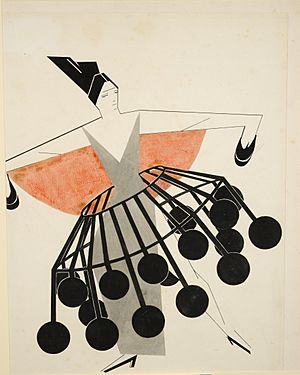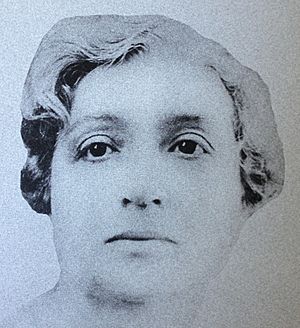Aleksandra Ekster facts for kids
Quick facts for kids
Aleksandra Aleksandrovna Èkster
|
|
|---|---|
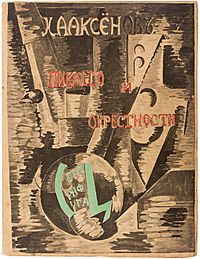
Alexandra Exter, 1917, Pikasso I Okrestnosti, Moscow, Tsentrifuga (cover)
|
|
| Born |
Aleksandra Aleksandrovna Grigorovich
18 January 1882 Białystok, Grodno Governorate
|
| Died | 17 March 1949 (aged 67) |
| Nationality | Russian Empire |
| Known for | Painting, graphic arts, stage design, costume design |
| Movement | Futurism, cubism, constructivism |
Aleksandra Aleksandrovna Ekster (born Grigorovich) (Russian: Алекса́ндра Алекса́ндровна Эксте́р, Ukrainian: Олекса́ндра Олекса́ндрівна Е́кстер; 18 January 1882 – 17 March 1949), also known as Alexandra Exter, was a famous Russian and French artist. She was a painter and designer.
As a young woman, her art studio in Kyiv was a popular meeting spot for creative people. She also became well-known in Paris, where she met famous artists like Pablo Picasso and Georges Braque. She is known for her work in the Russian and Ukrainian avant-garde art movements. These include Cubo-futurism and Constructivism. She also influenced the Art Deco style.
Contents
Biography
Early Life and Education
Aleksandra Aleksandrovna Grigorovich was born in Białystok. This city was part of the Russian Empire then, but it is now in Poland. Her family was wealthy. Her father, Aleksandr Grigorovich, was a successful businessman. Her mother was Greek.
Young Aleksandra received an excellent private education. She learned languages, music, and art. She also took private drawing lessons. Later, her family moved to Kyiv. There, she attended St. Olga gymnasium and the Kyiv Art School. She studied painting and graduated in 1906.
Marriage and Travel
In 1908, Aleksandra Grigorovich married Nikolai Evgenyevich Ekster. He was a successful lawyer in Kyiv. The Eksters were part of Kyiv's cultural and intellectual society. She spent several months with her husband in Paris. While there, she studied at the Académie de la Grande Chaumière art school. From 1908 to 1924, she lived in many cities. These included Kyiv, St. Petersburg, Odessa, Paris, Rome, and Moscow.
Her Studio in Kyiv
Her painting studio was in an attic in Kyiv. It became a popular place for smart and creative people to gather. Future famous artists like Vadim Meller and Anatole Petrytsky worked there. Poets, writers, and dancers also visited her studio. Many artists and students came to learn from her. In 1908, she showed her art in an exhibition in Kyiv. She exhibited with a group called Zveno (Link).
Time in Paris
In Paris, Aleksandra Ekster met Pablo Picasso and Georges Braque. They introduced her to other important people in the art world. She showed her art in several exhibitions in Paris. One was the Salon de la Section d'Or in 1912. She exhibited alongside famous artists like Jean Metzinger and Marcel Duchamp.
In 1914, Ekster also took part in the Salon des Indépendants in Paris. She showed her work with other Russian and French artists. That same year, she participated in the International Futurist Exhibition in Rome. In 1915, she joined an art group called Supremus. Her friend introduced her to the poet Guillaume Apollinaire. He took her to Picasso's art studio.
Her home in Paris was a mix of cultures. It had European paintings by Picasso and Braque. But it also had Ukrainian embroidery and carpets. This showed her connection to both European and Ukrainian life.
Russian Avant-garde Art
Ekster was a very experimental artist. She was part of the Russian avant-garde movement. This means she was always trying new and different ways of making art. She was known as a Suprematist and Constructivist painter. She also had a big influence on the Art Deco style.
Ekster learned from many different cultures and art styles. This helped her create her own unique look. In 1915–1916, she worked with peasant craft groups in villages. She worked with other avant-garde artists like Kazimir Malevich. Later, she started a teaching workshop in Kyiv. Many artists worked and learned there. She also became a leading stage designer for the Chamber Theatre.
In 1919, she helped decorate the streets of Kyiv and Odessa. She used abstract art for Revolution Festivities. She also designed costumes for a ballet studio.
In 1921, she became a director at a major art school in Moscow called VKhUTEMAS. She taught a course on color there until 1924. Her art was shown in the 5x5=25 exhibition in Moscow in 1921.
Ekster's early paintings influenced her costume designs and book illustrations. All her works, no matter the type, had her special style. Her art was bright, fun, dramatic, and theatrical. She always kept her unique look across all her art.

Her art often used geometric shapes. This made her work feel energetic and vibrant. She used bold colors and free brushstrokes. Ekster applied these ideas to all her projects. Her theatrical works, like sculptures, costumes, and stage sets, showed her love for geometric shapes and bright colors. She experimented with how fabrics moved and looked in her costumes. Her stage sets used many colors and explored different ways to use space. She continued these experiments in her later puppet designs.
Ekster also started to bring her costume design ideas into everyday life. In 1921, she began designing fashion. While some of her designs were for mass production, many were very decorative and new. These were often like high fashion.
In 1923, she continued to work in many art forms. She also helped design the pavilions for the All-Russian Exhibition in Moscow.
Moving to France
In 1924, Aleksandra Ekster and her husband moved to France. They settled in Paris. She first became a professor at the Academie Moderne. From 1926 to 1930, she taught at Fernand Léger's Académie d'Art Contemporain.
In 1933, she started creating beautiful illuminated manuscripts. These were paintings on paper, often with text. Her "Callimaque" manuscript, made around 1939, is considered her best work from this time. In 1936, she showed her art in the Cubism and Abstract Art exhibition in New York. She also had her own art shows in Prague and Paris.
She worked as a book illustrator for a publishing company in Paris from 1936 until she passed away. In recent years, her art has become much more famous and valuable. Because her art became so popular, some fake artworks have appeared on the market.
See also
 In Spanish: Aleksandra Ekster para niños
In Spanish: Aleksandra Ekster para niños


